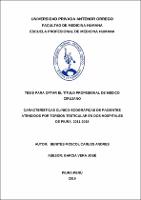| dc.contributor.advisor | García Vera, José | |
| dc.contributor.author | Benites Moscol, Carlos Andrés | |
| dc.creator | Benites Moscol, Carlos Andrés | |
| dc.date.accessioned | 2020-03-05T01:39:46Z | |
| dc.date.available | 2020-03-05T01:39:46Z | |
| dc.date.issued | 2020 | |
| dc.identifier.uri | https://hdl.handle.net/20.500.12759/6045 | |
| dc.description.abstract | Objetivo: Determinar las características clínico- ecográficas (doppler) de pacientes atendidos por torsión testicular en dos hospitales de Piura 2011-2018.
Material y Métodos: Estudio retrospectivo, en el Departamento de Cirugía de servicio de Urología del Hospital II-2 Santa Rosa y del Hospital José Cayetano Heredia, Piura, año 2011-2018. Se incluyeron 44 pacientes que hayan sido diagnosticados por torsión testicular, mediante muestreo censal, se excluyeron aquellos que no cumplían con criterios de selección. Los datos se recolectaron de las historias clínicas de archivo del departamento de Urología. El análisis se realizó con porcentajes, promedios, chi2, Test de Student. Se calculó las razones de prevalencia crudas (RPc) y ajustadas (RPa) mediante modelos lineales generalizados, usando Poisson, para el análisis bivariado y multivariado.
Resultados: A nivel general encontramos 44 casos diagnosticados por torsión testicular entre los años 2011 a 2018 en dos hospitales de Piura ; de estos los años con mayor aparición fueron en el 2012 con un 18,2% (8 casos), seguidos por el año 2013 con un 15,9 %(7 casos).El promedio de edad fue de 14.2 años.Las Características clínicas de los pacientes atendidos por torsión testicular, que encontramos fue un paciente con dolor testicular que represento un 97,7% (43 casos); seguido por edema testicular con 59,1% (26 casos); así también el aumento de la temperatura corporal fue lo que menos se present0 con solo 03 casos (6,8%). A nivel de ecografía (doppler) encontramos que la hipoecogenicidad fue lo más encontrado con 29 de los casos (90.62%), seguido de aumento de volumen testicular con 28 de los casos (87.5%) y finalmente disminución del flujo sanguíneo con 24 casos (75%).
Conclusiones: Durante el período 2011-2018 se reportaron 44 casos de torsión testicular, de los cuales las características clínicas que más se presentaron fueron el dolor testicular y edema testicular; y a nivel de ecografía doppler la hipoecogenicidad y el aumento de volumen testicular fue lo mayor encontrado en el estudio. | es_PE |
| dc.description.abstract | Objetive: To determine the clinical characteristics- ultrasound of patients treated for testicular torsion in two hospitals of Piura 2011-2018.
Material and methods: Retrospective study, in the Department of Surgery of Urology service of Hospital II-2 Santa Rosa and Hospital José Cayetano Heredia, Piura, 2011-2018. Forty-four patients who had been diagnosed by testicular torsion were included, by census sampling, those who did not meet the selection criteria were excluded. The data were collected from the medical records of the department of Urology. The analysis was performed with percentages, averages, chi2, Student's test. Crude prevalence ratios (RPc) and adjusted (RPa) were calculated using generalized linear models, using Poisson, for bivariate and multivariate analysis.
Results: At a general level, we found 44 cases diagnosed by testicular torsion between 2011 and 2018 in two hospitals in Piura; of these the years with the highest appearance were in 2012 with 18.2% (8 cases), followed by the year 2013 with 15.9% (7 cases). The average age was 14.2 years. The clinical characteristics of the patients treated for testicular torsion, which we found was a patient with testicular pain that represented 97.7% (43 cases); followed by testicular edema with 59.1% (26 cases); Thus, the increase in body temperature was the least observed with only 03 cases (6.8%). At the ultrasound level we found that hypoechogenicity was the most frequent with 29 cases (90.62%), followed by of increase in testicular volume with 28 cases (87.5%) and finally decrease in blood flow with 24 cases (75%).
Conclusions: During the 2011-2018 period, 44 cases of testicular torsion were reported, of which the clinical features that most occurred were testicular pain and testicular edema; and at the level of Doppler ultrasonography, hypoechogenicity and increased testicular volume was the greatest found in the study. | en_US |
| dc.description.uri | Tesis | es_PE |
| dc.format | application/pdf | es_PE |
| dc.language.iso | spa | es_PE |
| dc.publisher | Universidad Privada Antenor Orrego | es_PE |
| dc.relation.ispartofseries | T_MEDP_138 | |
| dc.rights | info:eu-repo/semantics/openAccess | es_PE |
| dc.rights.uri | https://creativecommons.org/licenses/by/4.0/ | es_PE |
| dc.source | Universidad Privada Antenor Orrego | es_PE |
| dc.source | Repositorio Institucional - UPAO | es_PE |
| dc.subject | Torsión testicular | es_PE |
| dc.subject | Ecografía doppler | es_PE |
| dc.title | Características clínico-ecográficas de pacientes atendidos por torsión testicular en dos hospitales de Piura 2011-2018 | es_PE |
| dc.type | info:eu-repo/semantics/bachelorThesis | es_PE |
| thesis.degree.level | Título Profesional | es_PE |
| thesis.degree.grantor | Universidad Privada Antenor Orrego. Facultad de Medicina Humana | es_PE |
| thesis.degree.name | Médico Cirujano | es_PE |
| thesis.degree.discipline | Medicina Humana | es_PE |
| dc.subject.ocde | https://purl.org/pe-repo/ocde/ford#3.02.27 | es_PE |
| renati.type | https://purl.org/pe-repo/renati/type#tesis | es_PE |
| renati.level | https://purl.org/pe-repo/renati/level#tituloProfesional | es_PE |
| renati.discipline | 912016 | es_PE |
| dc.publisher.country | PE | es_PE |


